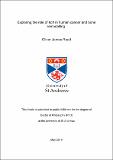Files in this item
Exploring the role of Itch in human cancer and bone remodelling
Item metadata
| dc.contributor.advisor | Harrison, David James | |
| dc.contributor.author | Read, Oliver James | |
| dc.coverage.spatial | vii, 204 p. | en_US |
| dc.date.accessioned | 2019-10-16T15:47:50Z | |
| dc.date.available | 2019-10-16T15:47:50Z | |
| dc.date.issued | 2019-12-03 | |
| dc.identifier.uri | https://hdl.handle.net/10023/18692 | |
| dc.description.abstract | Tight control of post-translational modifications such as ubiquitination is important for cell homeostasis and dysregulation of this process is a common feature in many diseases. Itch encodes an E3 ubiquitin ligase that conjugates ubiquitin to a variety of substrates such as Jun B, PKC-θ, PLC- γ1, LATS, TXNIP and p73. In this study both transient and stable knockdown techniques (siRNA and CRISPR respectively) were utilised to explore the role of Itch in both cancer progression and bone remodelling. Transient siRNA-mediated knockdown of Itch inhibited cell viability of MiaPaCa-2 and Capan-2 cell lines by ~50% and ~60% respectively compared to both scrambled and untreated controls as determined by SRB. Although siRNA did not increase cell line sensitivity to γ-radiation, doxorubicin, and gemcitabine, it did have an additive effect on resultant survivability. CRISPR-Cas9 mediated stable Itch knockdowns in the same cell lines in contrast showed increased sensitivity to the aforementioned treatment regimens however resultant data obtained from cell survival and clonogenicity assays suggested that the CRISPR⁺ MiaPaCa-2 cells divide faster than both scrambled and parental controls. SWATH-DIA analysis was performed to look for differences in proteome between CRISPR⁺ and parental MiaPaCa-2 cells. Preliminary data based on isogenic clones suggests potential differences, but additional repeats and further validation is required. Transient Itch knockdown in peripheral blood monocytes increased their capacity to differentiate into fully matured osteoclasts ex-vivo: compared to untreated controls, si-Itch treated wells showed higher mean numbers of large TRAP⁺ cells (mean = 63 and 54 for si-Itch and untreated wells respectively) and multinucleate cells (mean = 25 and 17 for si-Itch and untreated wells respectively) in a 96-well format. Meanwhile CRISPR-mediated knockdown induced a large degree of cellular toxicity in PBMCs. This contrast between stable and transient Itch knockdown prompted discussion of the strengths and weaknesses of each technique and their suitability in different experimental contexts. | en_US |
| dc.language.iso | en | en_US |
| dc.publisher | University of St Andrews | |
| dc.rights | Creative Commons Attribution-NonCommercial-NoDerivatives 4.0 International | * |
| dc.rights.uri | http://creativecommons.org/licenses/by-nc-nd/4.0/ | * |
| dc.subject | Itch | en_US |
| dc.subject | E3 ligase | en_US |
| dc.subject | Cancer | en_US |
| dc.subject | Bone remodelling | en_US |
| dc.subject | siRNA | en_US |
| dc.subject | CRISPR | en_US |
| dc.subject.lcc | RB155.5R4 | |
| dc.subject.lcsh | Medical genetics | en |
| dc.subject.lcsh | Ligases | en |
| dc.subject.lcsh | Cancer cells | en |
| dc.subject.lcsh | Bone remodeling | en |
| dc.subject.lcsh | Small interfering RNA | en |
| dc.subject.lcsh | CRISPR (Genetics) | en |
| dc.title | Exploring the role of Itch in human cancer and bone remodelling | en_US |
| dc.type | Thesis | en_US |
| dc.type.qualificationlevel | Doctoral | en_US |
| dc.type.qualificationname | PhD Doctor of Philosophy | en_US |
| dc.publisher.institution | The University of St Andrews | en_US |
| dc.identifier.doi | https://doi.org/10.17630/10023-18692 |
The following licence files are associated with this item:
This item appears in the following Collection(s)
Except where otherwise noted within the work, this item's licence for re-use is described as Creative Commons Attribution-NonCommercial-NoDerivatives 4.0 International
Items in the St Andrews Research Repository are protected by copyright, with all rights reserved, unless otherwise indicated.


